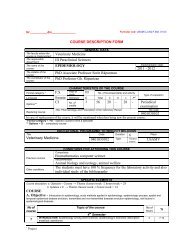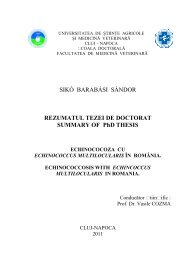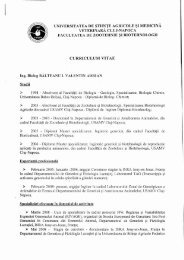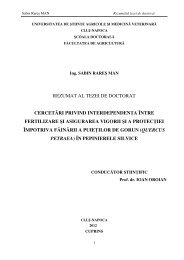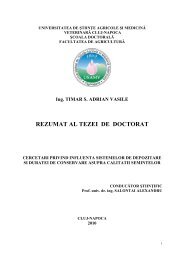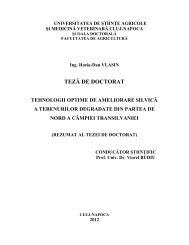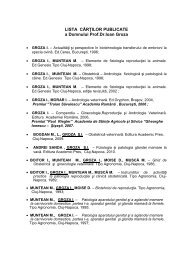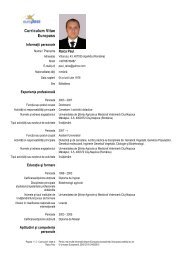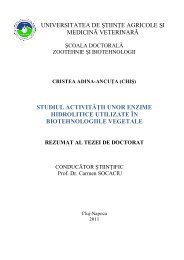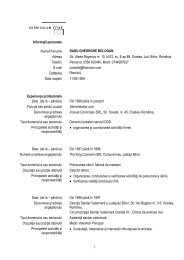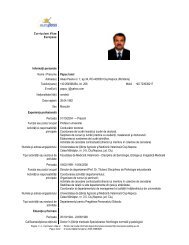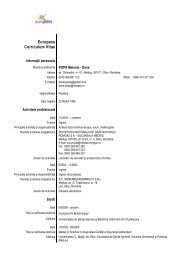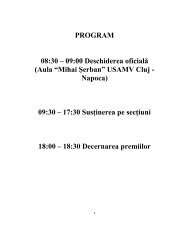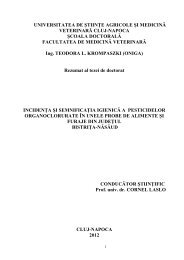Marioara Urda _Grebenisan_ rezumat_teza_engleza - USAMV Cluj ...
Marioara Urda _Grebenisan_ rezumat_teza_engleza - USAMV Cluj ...
Marioara Urda _Grebenisan_ rezumat_teza_engleza - USAMV Cluj ...
You also want an ePaper? Increase the reach of your titles
YUMPU automatically turns print PDFs into web optimized ePapers that Google loves.
<strong>Marioara</strong> GREBENIŞAN Summary of the PhD thesis<br />
Research on the structure of di- and tetraploid red clover seed plants and the influence of meiotic<br />
anomalies on the fertility of autotetraploid forms<br />
2.3. Climatic conditions in which experiments were conducted ……..<br />
2.3.1. Thermal regime ………………………………………….<br />
2.3.2. Rainfall …………………………………………………...<br />
2.3.3. Other weather conditions …………………………………<br />
C H A P T E R I I I<br />
3. Research on the structure of red clover seed plants and the effect on<br />
seed yield ……………………………………………………………..<br />
3.1. Introduction ………………………………………………………<br />
3.2. Materials and methods …………………………………………...<br />
3.3. Results and discussion …………………………………………...<br />
3.3.1. Components of red clover seed yield …………………….<br />
3.3.1.1. Number of flower heads/plant and per s. m ………<br />
3.3.2. The number of flowers/flower head ……………………...<br />
3.3.3. The number of seeds per flower head …………………….<br />
3.3.4. The average percentage of seeds formation ………………<br />
3.3.5. Thousand kernel weight (TKW) ………………………….<br />
3.3.6. The calculated and real seed yield ………………………..<br />
3.3.6.1. Flowering stages and seed yield ………………….<br />
C A P I T O L U L I V<br />
4. Pollination and seed formation process in diploid and tetraploid red clover<br />
(Trifolium pratense L.) for Transylvania conditions ………………………<br />
4.1. Red clover pollination particularities in relation with the number and type<br />
of pollinators ………………………………………………………….<br />
4.1.1. Introduction ………………………………………………<br />
4.1.1.1. Research method …………………………………<br />
4.2. Result and disscutions …………………………………………<br />
4.2.1. Abiotic and biotic factors involved in red clover<br />
pollination ………………………………………………...<br />
4.2.2. Flowering period …………………………………………<br />
4.2.3. Pollinators distribution in seed crops …………………….<br />
4.2.4. Total number of bees and bumble bees …………………..<br />
4.2.5. Daily frequency of bees and bumble bees ………………..<br />
4.2.6. Bees and bumble bees waiting time on red clover flower<br />
heads ………………………………………………………....<br />
4.2.7. Comparative aspects regarding the total number of<br />
“insect-units” and the relative fertility of red clover …….<br />
4.3. Aspects of correlation between weather conditions and pollinators<br />
flight …………………………………………………………….<br />
CHAPTER V<br />
5. The comparative effects of the micro- and macrosporogenesis of the red<br />
clover with different levels of ploidy, in relation with its fertility ………<br />
5.1. The evolution of embryogenesis and its influence on fertility ….<br />
3<br />
68<br />
70<br />
72<br />
75<br />
76<br />
76<br />
81<br />
84<br />
84<br />
85<br />
89<br />
94<br />
96<br />
98<br />
100<br />
105<br />
113<br />
113<br />
113<br />
115<br />
116<br />
116<br />
122<br />
125<br />
127<br />
129<br />
132<br />
133<br />
135<br />
139<br />
139



